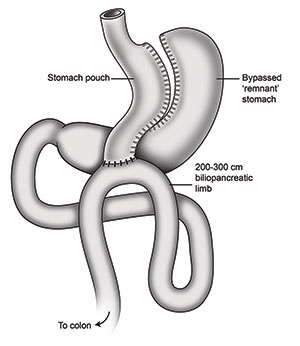Mini Gastric Bypass (MGB)
 Also known as Single Anastamosis or Omega Loop gastric bypass. The mini gastric bypass works both by restricting the amount of food that can be eaten at any one time, and by causing malabsorption and also by altering gut hormones involved in appetite control.
Also known as Single Anastamosis or Omega Loop gastric bypass. The mini gastric bypass works both by restricting the amount of food that can be eaten at any one time, and by causing malabsorption and also by altering gut hormones involved in appetite control.
The main difference between the standard roux-en-y gastric bypass (RYGB) and the MGB is that there is only one join or anastamosis, whereas in the RYGB there are two – an upper and a lower. Because of this the MGB can be done in less time than the RYGB and – at least theoretically – with fewer early complications.
In the first part of mini gastric bypass surgery the stomach is divided and a small tube of stomach created which becomes the pouch. This is the restrictive part of the procedure and means that only a small amount of food can be taken at any one time. Next, the surgeon brings up a loop of bowel (about 200-300cm long) and joins this to the lower part of the stomach pouch. This means that food passes from the small pouch into the small bowel where it meets the digestive juices which have moved downwards from the main part of the stomach. In effect, therefore, about 2-3 metres of small bowel has been bypassed before absorption of food (and calories) can take place. Fewer calories absorbed, means weight loss.
 Consultant Laparoscopic & Bariatric Surgeon
Consultant Laparoscopic & Bariatric Surgeon





